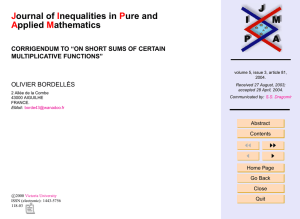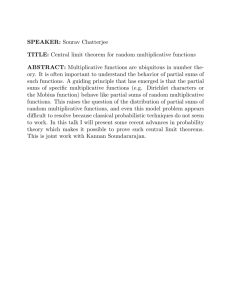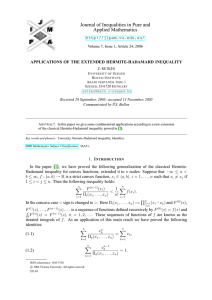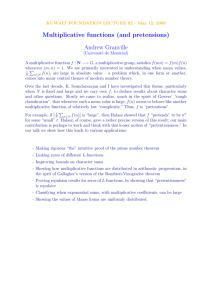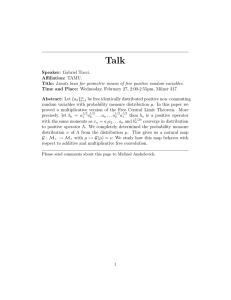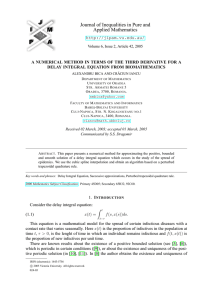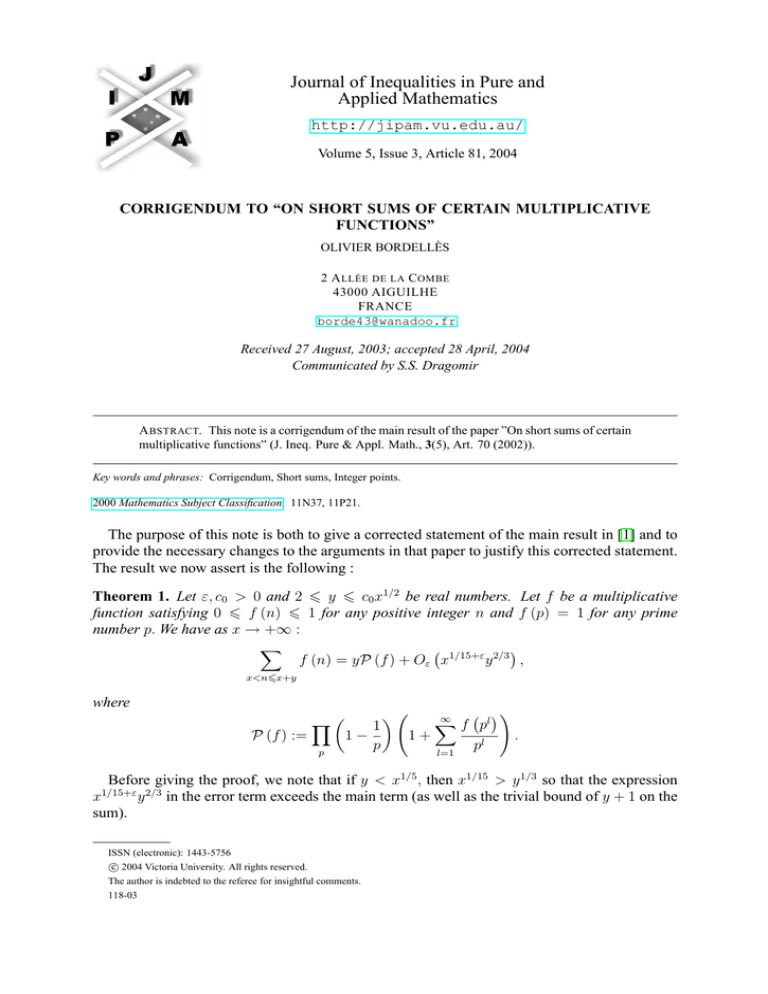
Journal of Inequalities in Pure and
Applied Mathematics
http://jipam.vu.edu.au/
Volume 5, Issue 3, Article 81, 2004
CORRIGENDUM TO “ON SHORT SUMS OF CERTAIN MULTIPLICATIVE
FUNCTIONS”
OLIVIER BORDELLÈS
2 A LLÉE DE LA C OMBE
43000 AIGUILHE
FRANCE
borde43@wanadoo.fr
Received 27 August, 2003; accepted 28 April, 2004
Communicated by S.S. Dragomir
A BSTRACT. This note is a corrigendum of the main result of the paper ”On short sums of certain
multiplicative functions” (J. Ineq. Pure & Appl. Math., 3(5), Art. 70 (2002)).
Key words and phrases: Corrigendum, Short sums, Integer points.
2000 Mathematics Subject Classification. 11N37, 11P21.
The purpose of this note is both to give a corrected statement of the main result in [1] and to
provide the necessary changes to the arguments in that paper to justify this corrected statement.
The result we now assert is the following :
Theorem 1. Let ε, c0 > 0 and 2 6 y 6 c0 x1/2 be real numbers. Let f be a multiplicative
function satisfying 0 6 f (n) 6 1 for any positive integer n and f (p) = 1 for any prime
number p. We have as x → +∞ :
X
f (n) = yP (f ) + Oε x1/15+ε y 2/3 ,
x<n6x+y
where
P (f ) :=
Y
p
1
1−
p
∞
X
f pl
1+
pl
l=1
!
.
Before giving the proof, we note that if y < x1/5 , then x1/15 > y 1/3 so that the expression
x
y in the error term exceeds the main term (as well as the trivial bound of y + 1 on the
sum).
1/15+ε 2/3
ISSN (electronic): 1443-5756
c 2004 Victoria University. All rights reserved.
The author is indebted to the referee for insightful comments.
118-03
2
O LIVIER B ORDELLÈS
Proof. On page 5 of [1], the sum
X
S1 :=
|g (d)|
y<d6x+y
d squarefull
has been bounded by the sum
X
S2 :=
X
b6(x+y)1/3
1/2
( by3 )
h i
x+y
x
−
d
d
1/2
−3 (x + y) b−3
xb
−
a2
a2
<a6( x+y
3 )
b
by using d = a2 b3 with µ2 (b) = 1, and S2 has been bounded by
x
y ε xε
max
R 3 , B, 3
b
B
16B6(x+y)1/3
for any (small) positive real number ε, where we defined R (f, N, δ) to be the number
P of integer
points (n, m) verifying n ∈ ]N ; 2N ] and |f (n) − m| 6 δ. Unfortunately, the part b6y1/3 of S2
cannot be estimated by max16B6(x+y)1/3 R bx3 , B, By3 , hence we have to proceed differently:
for any positive integer r, we set
X
τ(r) (n) :=
1
dr |n
and recall that
τ(r) (n) ε nε/r
for any positive integers n, r.
In S1 , d = a2 b3 > y implies a > y 1/5 or b > y 1/5 . Since
−2 X
X
(x + y) a−2
xa
−
3
b
b3
y 1/5 <a6(x+y)1/2 ( y )1/3 <b6( x+y )1/3
a2
a2
X
X
y 1/5 <a6(x+y)1/2
x
<n6 x+y
a2
a2
6
and we have the same if b > y 1/5 , then
X
X
S1 6
τ(2) (n) +
x+y
y 1/5 <b6(x+y)1/3 bx3 <n6 b3
X
=
X
X
X
x+y
y 1/5 <a6(2y)1/2 ax2 <n6 a2
X
τ(3) (n)
x+y
y 1/5 <a6(x+y)1/2 ax2 <n6 a2
X
τ(2) (n) +
x+y
y 1/5 <b6(2y)1/3 bx3 <n6 b3
+
X
τ(3) (n)
(2y)
1/3
τ(3) (n) +
X
τ(2) (n)
x+y
<b6(x+y)1/3 bx3 <n6 b3
X
X
τ(3) (n)
x+y
(2y)1/2 <a6(x+y)1/2 ax2 <n6 a2
:= Σ1 + Σ2 + Σ3 + Σ4 .
• For Σ1 and Σ3 we use the trivial bound:
h i
h i
X
X
x+y
x
x+y
x
ε/2
ε/3
Σ1 + Σ3 ε x
− 3
+x
− 2
3
2
b
b
a
a
y 1/5 <b6(2y)1/3
y 1/5 <a6(2y)1/2
X 1
X 1
ε y 4/5 xε/2 .
ε xε/2 y
+
3
2
b
a
1/5
1/5
b>y
a>y
J. Inequal. Pure and Appl. Math., 5(3) Art. 81, 2004
http://jipam.vu.edu.au/
3
CORRIGENDUM
• For Σ2 , we use the method of [1] to get
Σ2 ε xε x1/6 + y 1/3 .
• For Σ4 , if we suppose y 6 c0 x1/2 (where c0 > 0 is sufficiently small), we have using
Lemmas 2.1 and 2.2 of [1]:
(
)
x
x
y y ε
max
R 2 , A, 2 + −1 max
Σ4 ε x
R 2 , A, 2
a
A
a
A
c0 y<A6x1/2
(2y)1/2 <A6c−1
0 y
ε xε (xy)1/6 + x1/5 + x1/15 y 2/3 .
Hence we finally have
S1 ε xε x1/15 y 2/3 + y 4/5 + (xy)1/6 + x1/5 + x1/6 + y 1/3
ε xε x1/15 y 2/3 + y 4/5
if y > x1/5 . Note that y 4/5 x1/15 y 2/3 if y 6 c0 x1/2 and that
X
f (n) − yP (f ) y x1/15 y 2/3
x<n6x+y
if y < x
1/5
. This concludes the proof of the theorem.
R EFERENCES
[1] O. BORDELLÈS, On short sums of certain multiplicative functions, J. Inequal. Pure and Appl.
Math., 3(5) (2002), Art. 70. [ONLINE: http://jipam.vu.edu.au/article.php?sid=
222]
J. Inequal. Pure and Appl. Math., 5(3) Art. 81, 2004
http://jipam.vu.edu.au/

